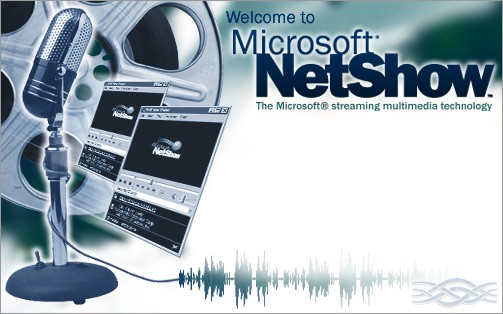Definition of Microsoft NetShow in Network Encyclopedia.
What is Microsoft NetShow?
NetShow was a client/server networked streaming multimedia system for bringing rich broadcasting features to the Web.

Using Microsoft NetShow Player, the client software, users can watch and listen to live or recorded broadcasts from NetShow servers without having to wait for downloads to complete.
NetShow Player, which is included with Microsoft Internet Explorer, forwards audio or video files to the browser for display within a browser window or frame.
NetShow supports various delivery formats, including the following:
- Audio, illustrated audio, and video-on-demand
- Synchronized audio and video
- Live Internet Protocol (IP) multicast audio, video, and file transfer
NetShow has the following four components:
- Microsoft NetShow Server: For transmitting audio, video, and files to Microsoft Windows clients by using unicasting or multicasting.
- NetShow Administrator: For configuring and monitoring NetShow servers and managing NetShow channels, programs, and streams.
- NetShow clients: For receiving and rendering streams transmitted by NetShow servers. NetShow Player is an example.
- NetShow content and conversion tools: For converting live audio and video to Advanced Streaming Format (the ASF Real-Time Encoder, for example) and for assembling, synchronizing, and compressing audio and video files into a single .asf file (the ASF Editor, for example). Conversion tools are also included for converting .mov, .avi, and .wav files to .asf format.
NetShow History
NetShow 1.0 came out in 1996. A newer version, 2.0, was included in Windows NT 4.0 SP3 in 1997. Version 3.0 came out mid-1998. The whole product line was renamed Windows Media in October 1999, four months before Windows 2000 appeared.
The NetShow name is still carried on in the user-agent string in current versions of Windows Media Player, which reports as “NSPlayer”.
Microsoft NetShow Server
NetShow Server is the server site of the Microsoft NetShow client/server streaming media delivery system. NetShow Server is implemented as a series of Microsoft Windows NT services that can deliver streaming audio, video, and other files over TCP/IP networks (such as the Internet) to NetShow Player clients.
How NetShow Server works
NetShow Server can deliver streaming media content in two ways:
- Unicasting: NetShow Server sends a separate copy of the data to any client that requests it. Unicasting involves computers establishing a two-way, point-to-point connection. The advantage of unicasting streaming media content is that the client can communicate with the server that supplies the multimedia stream. For example, the client can request that the server pause the stream. The disadvantage is that each client requires a separate stream, which can rapidly use up available bandwidth.
- Multicasting: NetShow Server sends a single copy of the data to all clients that request it. Multicasting involves a server sending a single copy of the data stream over the network to multiple clients. The advantage of multicasting streaming data is that only one copy of the data is sent over the network, which uses much less bandwidth than unicasting. The disadvantage is that multicasting is connectionless, so clients have no control over the streams they receive.
NetShow Server can deliver content either live or on-demand. Live content is delivered in conjunction with the NetShow Real-Time Encoder, which compresses the audio/video feed in real-time before passing it to NetShow Server for delivery.
Use of multicasting
You cannot use multicasting unless the routers on your network support multicasting. Unlike broadcasts, routers can control where multicasts travel on a network. If clients are behind a firewall, you can configure NetShow channels to offer clients unicasts instead of multicasts.
Channel in Microsoft NetShow
What is Channel in Microsoft NetShow?
In Microsoft NetShow, Channel is a mechanism that supplies clients with information needed to receive and render Advanced Streaming Format (ASF) streams. The channel specifies the multicast address and port number the clients should listen to in order to receive the stream.
The channel also specifies the data types and formats in the stream, enabling the client to correctly render the stream. NetShow saves channel information as files with the extension .nsc.
A NetShow channel is analogous to a television channel or a radio frequency: if a NetShow client is tuned to a channel at the right time, the client receives streaming information sent by the NetShow server.
NetShow channels also support additional features such as
- Roll over to unicast: If clients cannot receive a multicast, you can configure the channel so that they automatically receive a unicast of the same program.
- Stream distribution: On corporate TCP/IP networks whose routers do not support multicasting, one NetShow server can distribute a stream to other NetShow servers that are each located on separate local area network (LAN) segments. These secondary servers can then multicast to clients on their own LAN segment.
NetShow supports channels only when using ASF streams.